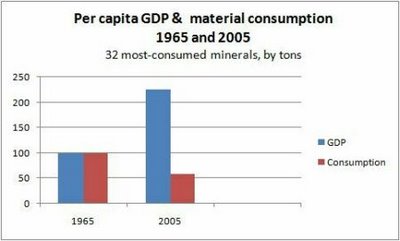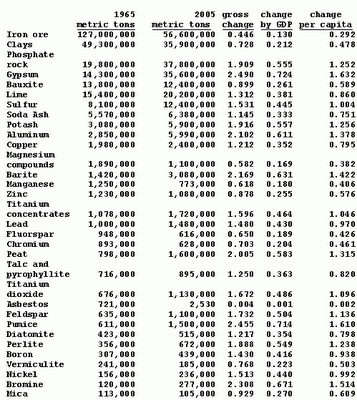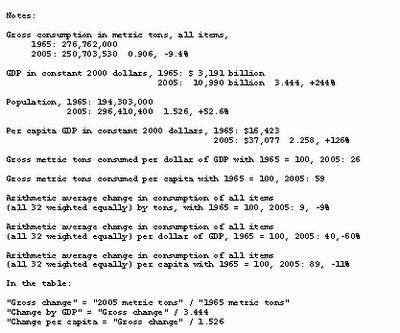Wednesday, April 22, 2009
Save the Earth. Grow the economy. Faster! Faster!
Today is Earth Day. And no doubt today you'll read and hear many complaints along the line of: "the Earth simply cannot withstand the strain of ever-increasing consumption of its resources by a perpetually growing economy..."
But don't you believe it. The facts and data below say something different. In fact, we are saving the Earth right now by becoming richer! This picture probably makes this fact clearer than any argument....

GDP per person 125% up! Consumption of the mineral wealth of the world 40% down! Remember this rule...
"The more advanced an economy grows, and the richer its population becomes, the less in physical resources it consumes."
Tell your environmentalist friends: to Save the Earth, grow its economies! Especially its most backward ones (but ours too). As fast as you can!
They may not get it right away. The idea that "the more advanced an economy grows the less it consumes" may seem counterintuitive at first ... but is easily explained -- and actually becomes self-evident to the point of being obvious after one ponders it a bit in light of the plain facts there in front of us all. (Sort of like the idea "the world is round" once was). But don't take my word for it, let's let the evidence speak for itself.
Fact: The amount of trash produced by the population of New York City peaked at over 2,000 pounds per person in the 1940s, and has since fallen to around 900 pounds -- yes, by more than 50%.
But that's just New York City, something unique might have happened there, how about the nation as a whole?
Fact: In the entire US economy people have consumed less of the material world on an individual basis as they have gotten richer. This was a topic Alan Greenspan enjoyed talking about during his tenure as head of the Federal Reserve...
1) An ever larger part of the economy is becoming "non-physical". Education, medicine, entertainment, electronic and film media, communications, finance, law and other non-manufacturing sectors of the economy, that comprise a steadily growing portion of GDP, consume very little in the way of the earth's natural resources -- so the common idea that a fast-growing economy must increase its consumption of natural resources at an equally fast rate is a very naive mistake.
2) Even in manufacturing, emphasis has shifted to the non-physical, conceptual part of products, reducing material consumption. In the early part of the 20th century the leading manufacturer was US Steel, which consumed vast amounts of iron ore, coal, and other material resources at a rapid rate. In the last part of the century the leading manufacturer was Intel, which spent billions of dollars figuring out how to arrange little bits of silicon (basically sand) in the most productive manner.
3) Even in the manufacturing of old fashioned products, the products are utilizing steadily less physical material. Cans were once made out of steel, then became tin cans made from real tin and opened with a heavy "church key" can opener, then became aluminum cans opened with a light can opener, then became pop-tops, and now have become light plastic, utilizing side products from the oil industry and containing no metal at all.
So for the weight of the physical components of the economy to grow only "modestly" over that time period means consumption of physical goods must have fallen per individual and plunged per dollar of GDP.
Oh ... but Alan was just an old guy talking, is there any real hard data available today that shows this process of "dematerializing" the economy is really happening now, by the numbers? Indeed there is!
Facts: To put together the data reflected in the chart at the top of this post, I went to the Historical Statistics for Mineral and Material Commodities in the United States of the US Geological Survey, which presents comprehensive data on mineral consumption in the US.
Going through its listing from "abrasives" to "zirconium" I selected the 32 minerals with the highest levels of consumption in metric tons, all over 100,000 in 1965 (omitting a few like "crushed rock" and "salt" which even the most rabid of greens won't allege we are depleting), and then compared the amounts of them consumed in 1965 and 2005.
Now, during those 40 years the GDP of the US multiplied to 3.444 times its 1965 level, and the US population grew by 52.6%, so GDP per capita consequently grew by 126% to 2.26 times its 1965 level -- the average American grew that much richer.
The consumption levels of the 32 minerals most-consumed changed thusly:
[] Per dollar of GDP, all 32 of 32 declined in consumption. Total metric tons consumed of all the minerals combined fell by 9%. With GDP multiplying 3.44-fold at the same time, this means the per dollar of GDP consumption of these minerals fell by 74%, to only 26% of its previous level.
That total of course is the (very literally) "weighted average" of the decline for all the items. If instead we look at the arithmetic average amount by which all the 32 minerals fell in consumption (with each weighted equally in computing the average) we see that measure of the average fell by 60%.
[] Per capita, 19 of the 32 minerals fell in consumption, so less was consumed of most of the minerals per person in the US in 2005 than in 1965. Adding all 32 together, their per capita consumption fell by 41% -- even as per capita income more than doubled!
Taking the arithmetic average for the 32 minerals, with each weighted equally, gives a per capita average reduction of 11%.
[] In absolute terms, 11 of the 32 declined outright in consumption, and the total consumption of all 32 declined in absolute terms by 9%.
So less of them in total actually had to be dug out of the ground to satisfy US consumers in 2005 than 1965 -- even with GDP more than tripling and US population increasing more than 50%!
"The bottom line is the bottom line" as they say, and that's the bottom line.
But the clearest picture in my opinion is that of the per person change in income and consumption of these materials, so here that is again. Americans getting richer while consuming less of the material world...

Tell your friends! Tell the whole world to copy us! "Get rich! Save your physical resources! Grow as fast as you can!"
Underneath are the full data that went into this analysis.
BTW, I'm sure someone will ask, "what about oil?" I'm saving energy resources for another post (and oil generally isn't measured in metric tons). But for the record, oil products consumed rose from 4,202,039 thousand barrels in 1965 to 7,592,789 in 2005, an increase of 81% in absolute terms.
That's also a decrease of 47% per dollar of GDP ... a decrease of 20% per dollar of GDP per capita ... and an increase of 18% per capita.
Update: John Tierney in the NY Times has a story on energy consumption making a similar point, Use Energy, Get Rich and Save the Planet.
~~~


~~~
But don't you believe it. The facts and data below say something different. In fact, we are saving the Earth right now by becoming richer! This picture probably makes this fact clearer than any argument....

GDP per person 125% up! Consumption of the mineral wealth of the world 40% down! Remember this rule...
"The more advanced an economy grows, and the richer its population becomes, the less in physical resources it consumes."
Tell your environmentalist friends: to Save the Earth, grow its economies! Especially its most backward ones (but ours too). As fast as you can!
They may not get it right away. The idea that "the more advanced an economy grows the less it consumes" may seem counterintuitive at first ... but is easily explained -- and actually becomes self-evident to the point of being obvious after one ponders it a bit in light of the plain facts there in front of us all. (Sort of like the idea "the world is round" once was). But don't take my word for it, let's let the evidence speak for itself.
Fact: The amount of trash produced by the population of New York City peaked at over 2,000 pounds per person in the 1940s, and has since fallen to around 900 pounds -- yes, by more than 50%.
The idea that America's output of garbage rises ever skyward -- more trash, year by passing year -- has become one of the great unchallenged assumptions about how the world works ...Remember that the average real income in New York City tripled from the 1940s to today, as trash per capita declined by more than half -- so trash per dollar of income fell by more than 83%: more wealth, less waste.
Daniel C. Walsh an adjunct professor at the Earth Institute at Columbia University, believed it too, until he began poking through the musty records in the New York City Archives and stumbled on a long-unread paper trail that he said might be unique among big American cities: 100 years of painstakingly kept records about what New Yorkers threw away...
Pounds of trash per person peaked not in the prosperous 1990's, but in 1940...
The great trend of the 20th century, Dr. Walsh concluded, has been toward less garbage -- or at least lighter garbage -- because the economics demanded it and technology made it possible.
"There are very significant forces out there that are working to minimize the mass of the waste stream," he said. "The forces are strong and they're incredibly effective"...
... the most profound conclusion that emerged from the records, Dr. Walsh said, was not the historical nuggets, but the underlying engine that produced them. The big economic drivers of the 20th century ... all moved in one direction: toward less waste, not more...
"Everything relates to two principal factors -- one is reducing costs, making things lighter and easier to transport, and the other is making them more convenient to the consumer..." [NY Times]
But that's just New York City, something unique might have happened there, how about the nation as a whole?
Fact: In the entire US economy people have consumed less of the material world on an individual basis as they have gotten richer. This was a topic Alan Greenspan enjoyed talking about during his tenure as head of the Federal Reserve...
...the rate of increase of the gross domestic product in the United States, adjusted for price change -- our measure of gains in the real value of output -- has averaged around three percent per year.What he is talking about here is three things:
Only a small fraction of that represents growth in the tonnage of physical materials -- oil, coal, ores, wood, raw chemicals, for example. The remainder represents new insights into how to rearrange those physical materials to better serve human needs... The share of the nation's output that is conceptual appears to have accelerated... [FedRes]
1) An ever larger part of the economy is becoming "non-physical". Education, medicine, entertainment, electronic and film media, communications, finance, law and other non-manufacturing sectors of the economy, that comprise a steadily growing portion of GDP, consume very little in the way of the earth's natural resources -- so the common idea that a fast-growing economy must increase its consumption of natural resources at an equally fast rate is a very naive mistake.
2) Even in manufacturing, emphasis has shifted to the non-physical, conceptual part of products, reducing material consumption. In the early part of the 20th century the leading manufacturer was US Steel, which consumed vast amounts of iron ore, coal, and other material resources at a rapid rate. In the last part of the century the leading manufacturer was Intel, which spent billions of dollars figuring out how to arrange little bits of silicon (basically sand) in the most productive manner.
3) Even in the manufacturing of old fashioned products, the products are utilizing steadily less physical material. Cans were once made out of steel, then became tin cans made from real tin and opened with a heavy "church key" can opener, then became aluminum cans opened with a light can opener, then became pop-tops, and now have become light plastic, utilizing side products from the oil industry and containing no metal at all.
And that means that each individual's consumption of physical assets has declined over history as the economy has grown. The nation's population more than tripled over those hundred years, from 76 million to about 275 million, and GDP grew about 25-fold.The physical weight of our gross domestic product is evidently only modestly higher today than it was fifty or one hundred years ago.
By far the largest contributor to growth of our price adjusted GDP, or value added, has been ideas -- insights that leveraged physical reality. [FedRes]
So for the weight of the physical components of the economy to grow only "modestly" over that time period means consumption of physical goods must have fallen per individual and plunged per dollar of GDP.
Oh ... but Alan was just an old guy talking, is there any real hard data available today that shows this process of "dematerializing" the economy is really happening now, by the numbers? Indeed there is!
Facts: To put together the data reflected in the chart at the top of this post, I went to the Historical Statistics for Mineral and Material Commodities in the United States of the US Geological Survey, which presents comprehensive data on mineral consumption in the US.
Going through its listing from "abrasives" to "zirconium" I selected the 32 minerals with the highest levels of consumption in metric tons, all over 100,000 in 1965 (omitting a few like "crushed rock" and "salt" which even the most rabid of greens won't allege we are depleting), and then compared the amounts of them consumed in 1965 and 2005.
Now, during those 40 years the GDP of the US multiplied to 3.444 times its 1965 level, and the US population grew by 52.6%, so GDP per capita consequently grew by 126% to 2.26 times its 1965 level -- the average American grew that much richer.
The consumption levels of the 32 minerals most-consumed changed thusly:
[] Per dollar of GDP, all 32 of 32 declined in consumption. Total metric tons consumed of all the minerals combined fell by 9%. With GDP multiplying 3.44-fold at the same time, this means the per dollar of GDP consumption of these minerals fell by 74%, to only 26% of its previous level.
That total of course is the (very literally) "weighted average" of the decline for all the items. If instead we look at the arithmetic average amount by which all the 32 minerals fell in consumption (with each weighted equally in computing the average) we see that measure of the average fell by 60%.
[] Per capita, 19 of the 32 minerals fell in consumption, so less was consumed of most of the minerals per person in the US in 2005 than in 1965. Adding all 32 together, their per capita consumption fell by 41% -- even as per capita income more than doubled!
Taking the arithmetic average for the 32 minerals, with each weighted equally, gives a per capita average reduction of 11%.
[] In absolute terms, 11 of the 32 declined outright in consumption, and the total consumption of all 32 declined in absolute terms by 9%.
So less of them in total actually had to be dug out of the ground to satisfy US consumers in 2005 than 1965 -- even with GDP more than tripling and US population increasing more than 50%!
"The bottom line is the bottom line" as they say, and that's the bottom line.
But the clearest picture in my opinion is that of the per person change in income and consumption of these materials, so here that is again. Americans getting richer while consuming less of the material world...

Tell your friends! Tell the whole world to copy us! "Get rich! Save your physical resources! Grow as fast as you can!"
Underneath are the full data that went into this analysis.
BTW, I'm sure someone will ask, "what about oil?" I'm saving energy resources for another post (and oil generally isn't measured in metric tons). But for the record, oil products consumed rose from 4,202,039 thousand barrels in 1965 to 7,592,789 in 2005, an increase of 81% in absolute terms.
That's also a decrease of 47% per dollar of GDP ... a decrease of 20% per dollar of GDP per capita ... and an increase of 18% per capita.
Update: John Tierney in the NY Times has a story on energy consumption making a similar point, Use Energy, Get Rich and Save the Planet.
~~~


~~~
